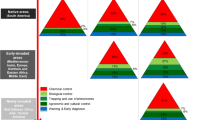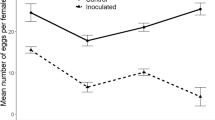Abstract
The tospovirus-plant-vector interaction is a specific and complex relationship. It is established that several factors influence this interaction leading to high variability of transmission efficiency of the virus within a vector population. We studied the contribution of vector gender to this interaction using Frankliniella occidentalis (western flower thrips) reared on either Tomato spotted wilt virus (TSWV) infected or uninfected Capsicum annum leaflets throughout their larval stages. Later pupae were individually transferred onto healthy leaf disks to examine the differences in: survival, development rate, transmission efficiency and feeding behavior between males and females in all the treatments. This was based on the hypothesis that sex of the vector influences transmission efficiency within the vector population. Our results showed that males had significantly higher longevity, lower mortality and shorter development time compared to females, while in the comparison of feeding behaviour, females were found to feed more intensively than males, regardless of whether they were exposed or unexposed to TSWV. Conversely, transmission efficiency; which referred to successful inoculation and establishment of the virus in the host plant after a given period of inoculative feeding, was found to be significantly higher in males compared to females, despite females having the highest percentage of transmitting individuals. These findings account in part for the high variability in vector competence of F. occidentalis within a population, which further give insight into the biological factors that may influence the transmission of TSWV by F. occidentalis.
Similar content being viewed by others
References
Assis Filho de FM, Deom CM & Sherwood JL, 2004. Replication of Tomato spotted wilt virus ingested into the alimentary canal of adult thrips. Phytopathology 94, 333–336.
Assis Filho de FM, Stavisky J, Reitz SR, Deom CM & Sherwood JL, 2005. Midgut infection by tomato spotted wilt virus and vector incompetence of Frankliniella tritici. J Appl Entomol 129, 548–550.
Belliure B, Janssen A, Maris PC, Peters D & Sabelis MW, 2005. Herbivore arthropods benefit from vectoring plant viruses. Ecol Lett 8, 70–79.
Broadbent AB & Allen WR, 1995. Interactions within the western flower thrips/Tomato spotted wilt virus/host plant complex on virus epidemiology. In: BL Parker, M Skinner & T Lewis (eds), Thrips Biology and Management, Plenum Press, New York. 193–196.
Bryan De & Smith RF, 1956. The Frankliniella occidentalis (Pergande) complex in California (Thysanoptera: Thripidae). U Calif Publ Entomol 10, 359–410.
Cabrera-La Rosa JC & Kennedy GG, 2007. Thrips tabaci and tomato spotted wilt virus: Inheritance of vector competence. Entomol Exp Appl 124, 161–166.
Chisholm IF & Lewis T, 1984. A new look at thrips (Thysanoptera) mouthparts, their action and effects of feeding on plant tissue. Bull Entomol Res 74, 663–675.
Crespi BJ, 1991. Heterozygosity in the haplodiploid Thysanoptera. Evolution 45, 458–464.
De Vries EJ, Breeuwer JAJ, Jacobs G & Mollema C, 2001a. The association of western flower thrips, Frankliniella occidentalis, with a near Erwinia species gut bacteria: transient or permanent? J Invertebr Pathol 77, 120–128.
De Vries EJ, Jacobs G & Breeuwer JAJ, 2001b. Growth and transmission of gut bacteria in the western flower thrips, Frankliniella occidentalis. J Invertebr Pathol 77, 129–137.
De Vries EJ, Jacobs G, Breeuwer JAJ, Sabelis MW & Menken SBJ, 2004. Diet dependent fitness effects of gut bacteria on their insect host: the symbiosis of Erwinia sp. and westernflower thrips. Proc R Soc Lond (B) 271, 2171–2178.
Dillon RJ, Vennard CT & Charnley AK, 2000. Exploitation of gut bacteria in the locust. Nature 403, 851.
Gillings MR, Rae D, Herron GA & Beattie GAC, 1995. Tracking thrips populations using DNA-based methods. In: Proceedings 1995 Australia and New Zealand Thrips Workshop: Methods, Biology, Ecology and Management. 97–103.
Goldbach R & Peters D, 1994. Possible causes of the emergence of tospovirus diseases. Seminars in Virology 5,113–120.
Haleweh N & Poehling HM, 2009. Inheritance of vector competence by the thrips Ceratothripoides claratris (Schumsher) (Thysanoptera: Thripidae). J Appl Entomol 133, 386–393.
Higgins CJ & Myers JH, 1992. Sex ratio patterns and population dynamics of western flower thrips (Thysanoptera: Thripidae). Environ Entomol 21, 322–330.
Ingwell LL, Eigenbrode SD & Bosque-Perez NA, 2012. Plant viruses alter insect behavior to enhance their spread. Sci Rep-UK 2, 578.
Inoue T & Sakurai T, 2006. Infection of Tomato spotted wilt virus (TSWV) shortens the life span of thelytokous Thrips tabaci (Thysanoptera: Thripidae). Appl Entomol Zool 41, 239–246.
Irving P, Troxler L, Heuer TS, Belvin M, Kopczynski C, Reichhart JM, Hoffmann JA & Hetr C, 2001. A genome-wide analysis of immune responses in Drosophila. P Natl Acad Sci USA 98, 15119–15124.
Kindt F, 2004. Probing behaviour of thrips: Behavioural study on the feeding of Western Flower Thrips related to Tomato spotted wilt virus transmission and host plant susceptibility. Thesis Wageningen University, The Netherlands.
Mandal B, Csinos AS, Martinez-Ochoa N & Pappu HR, 2008. A rapid and efficient inoculation method for Tomato spotted wilt virus. J Virol Meth 149, 195–198.
Mateus C, Araújo J & Mexia A, 2003. Evaluation of Frankliniella occidentalis (Thysanoptera:Thripidae) sex ratio in crops by two monitoring methods. Bol San Veg Plagas 29, 191–199.
Medeiros RB, Resende RO & Avila AC, 2004. The plant virus Tomato Spotted Wilt Tospovirus activates the immune system of its main insect vector, Frankliniella occidentalis. J Virol 78, 4976–4982.
Moritz G, 1997. Structure, growth and development. In: Thrips as Crop Pests (ed.) T Lewis. CAB Intern, Cambridge, UK. 15–63.
Moritz G, Kumm S & Mound L, 2004. Tospovirus transmission depends on thrips ontogeny. Virus Res 100, 143–149.
Mumford RA, Barker I & Wood KR, 1996. The biology of Tospoviruses. Ann Appl Biol 128, 159–183.
Nagata T, Inoue-Nagata AK, Smid HM, Goldbach R & Peters D, 1999. Tissue tropism related to vector competence of Frankliniella occidentalis for tomato wilt tospovirus. J Gen Virol 80, 507–515.
Nagata T, Inoue-Nagata AK, van Lent J, Goldbach R & Peters D, 2002. Factors determining vector competence and specifity for transmission of Tomato spotted wilt virus. J Gen Virol 83, 663–671.
Naidu RA, Sherwood JL & Deom CM, 2008. Characterization of a vector non-transmissible isolate of Tomato spotted wilt virus. Plant Pathol 57, 190–200.
Nault LR, 1994. Transmission biology, vector specificity and evolution of planthopper-transmitted plant viruses. In: RF Denno & TJ Perfect (eds.), Planthoppers: Their Ecology and Management. Chapman & Hall Inc., New York,429–448.
Ogada PA, Maiss E & Poehling HM, 2013. Influence of Tomato spotted wilt virus on performance and behaviour of western flower thrips (Frankliniella occidentalis). J Appl Entomol 137, 488–498.
Parrella G, Gognalons P, Gebre-Selassiè K, Vovlas C & Marchoux G, 2003. An update of the host range of Tomato spotted wilt virus. J Plant Pathol 85, 227–264.
Reitz SR, 2009. Biology and Ecology of the Western Flower Thrips (Thysanoptera: Thripidae): The making of a pest.Fla Entomol 92, 7–13.
Riley DG, Joseph SV, Srinivasan R & Diffie S, 2011. Thrips Vectors of Tospoviruses. J Interg Pest Mngmt 1(2). doi: 10.1603/IPM10020.
Rotenberg D, Krishna Kumar NK., Ullman DE, Mauricio MA, David KW, Thomas LG & Anna EW, 2009. Variation inTomato spotted wilt virus titer in Frankliniella occidentalis and its association with frequency of transmission. Phytopathology 99, 404–410.
Sakimura K, 1962. The present status of thrips-borne viruses. In: K Maramorosch (ed), Biological transmission of disease agents. Academic Press, New York, 33–40.
Sakurai T, Murai T, Maeda T & Tsumuki H, 1998. Sexual differences in transmission and accumulation of Tomato spotted wilt virus in its insect vector Frankliniella occidentalis (Thysanoptera: Thripidae). Appl Entomol Zool 33,583–588.
SAS Institute, 2002. SAS/STAT Software, Version 9.00. SAS Institute Inc., Cary, NC.
Scholthof K-BG, Adkins S, Czosnek H, Palukaitis P, Jacquot E, Hohn T, Hohn B, Saunders K, Candresse T, Ahlquist P, Hemenway C & Foster GD, 2011. Top 10 plant viruses in molecular plant pathology. Mol Plant Pathol 12, 938–954.
Sherwood JL, German TL, Moyer JW, Ullman De & Whitfield AE, 2000. Tomato spotted wilt. In: Encyclopedia of Plant Pathology, OC Maloy & TD Murray (eds.) John Wiley & Sons, New York. 1030–1031.
Shrestha A, Srinivasan R, Riley DG & Culbreath AK, 2012.Direct and indirect effects of a thrips-transmitted Tospovirus on the preference and fitness of its vector, Frankliniella fusca. Entomol Exp Appl 145, 260–271.
Singer MC, 1982. Sexual selection for small size in male butterflies. Am Nat 119, 440–443.
Stafford CA, Gregory PW & Ullman DE, 2011. Infection with a plant virus modifies vector feeding behavior. P Natl Acad Sci USA 108, 9350–9355.
Stumpf CF & Kennedy GG, 2007. Effects of Tomato spotted wilt virus isolates, host plants, and temperature on survival, size, and development time of Frankliniella occidentalis. Entomol Exp Appl 123, 139–147.
Terry I & Schneider M, 1993. Copulatory behaviour and mating frequency of the Western Flower Thrips Frankliniella occidentalis (Insecta: Thysanoptera). J Pure Appl Zool 4,339–354.
Thomas F, Adamo S & Moore J, 2005. Parasitic manipulation: where are we and where should we go? Behav Processes 68, 185–199.
Thornhill R & Alcock J, 1983. The Evolution of Insect Mating Systems. Cambridge, Mass: Harvard University Press.
Ullman DE, Cho JJ, Mau RFL, Westcot DM & Custer DM,1992. Midgut epithelial cells act as a barrier to Tomato spotted wilt virus acquisition by adult western flower thrips. Phytopathology 82, 1333–1342.
Ullman DE, German TL, Sherwood JL, Westcot DB & Cantone FA, 1993. Tospovirus replication in insect vector cells: Immunocytochemical evidence that the nonstructural protein encoded by the S RNA of Tomato spotted wilt tospovirus is present in thrips vector cells. Phytopathology 86, 900–905.
van de Wetering F, Golddach R & Peters D, 1996. Tomato spotted wilt tospovirus ingestion by the first instar larvae of Frankliniella occidentallis is a prerequisite for transmission.Phytopathology 86, 900–905.
van de Wetering F, Hulshof J, Posthuma K, Harrewijn P, Goldbach R & Peters D, 1998. Distinct feeding behaviour between sexes of Frankliniella occidentalis results in higher scar production and lower tospovirus transmission by females. Entomol Exp Appl 88, 9–15.
van de Wetering F, van der Hoek M, Goldbach R & Peters D, 1999a. Differences in Tomato spotted wilt virus vector competency between males and females of Frankliniella occidental. Entomol Exp Appl 93, 105–112.
van de Wetering F, van der Hoek M, Goldbach R, Mollema C & Peters D, 1999b. Variation in tospovirus transmission between populations of Frankliniella occidentalis (Thysanoptera: Thripidae). Bull Entomol Res 89, 579–588.
Whitfield AE, Ullman De & German TL, 2005. Tospovirus-thrips interactions. Ann Rev Phytopathol 43, 459–489.
Wijkamp I & Peters D, 1993. Determination of the median latent period of two tospoviruses in Frankliniella occidentalis, using a novel leaf disk assay. Phytopathology 83, 986–991.
Wijkamp I, van Lent J, Kormelink R, Goldbach R & Peters D, 1993. Multiplication of Tomato spotted wilt virus in its insect vector Frankliniella occidentalis. J Gen Virology 74, 341–349.
Wijkamp I, Almarza N, Goldbach R & Peters D, 1995. Distinct levels of specificity in thrips transmission of tospoviruses. Phytopathology 85, 1069–1074.
Wiklund C & Fagerström T, 1977. Why do males emerge before females? A hypothesis to explain the incidence of protandry in butterflies. Oecologia (Berl.) 31, 153–158.
Wiklund C & Solbreck C, 1982. Adaptive versus incidental explanations for the occurrence of protandry in a butterfly, Leptidea sinapis L. Evolution 36, 56–62.
Author information
Authors and Affiliations
Corresponding author
Rights and permissions
About this article
Cite this article
Ogada, P.A., Poehling, HM. Sex-Specific Influences of Frankliniella occidentalis (Western Flower Thrips) in the Transmission of Tomato Spotted Wilt Virus (Tospovirus). J Plant Dis Prot 122, 264–274 (2015). https://doi.org/10.1007/BF03356562
Received:
Accepted:
Published:
Issue Date:
DOI: https://doi.org/10.1007/BF03356562




